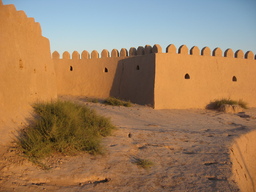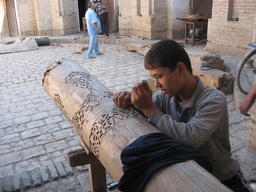
Atop City Walls, Khiva
 Atop City Walls, Khiva |
After declaring in my last entry how impressed I was by the elaborate beauty of Samarkand's Registan, I'm not sure how to describe Bukhara and Khiva. After three full days in each city I've found that both of these cities not only have Islamic architecture just as beautiful as that in Samarkand: each city hosts an even greater number of mosques, minarets, tombs, and schools--many just as beautiful as those I raved about in Samarkand.
The old city of Khiva is compact, still surrounded by walls built centuries ago. Despite spreading my visit over three days in such a small city, I've exhausted myself trying to see all the architecture.
Khiva has a well-preserved feel. Samarkand felt like a small, modern city, with beautiful old architecture scattered throughout. The old center of Bukhara felt a bit more chaotic and traditional. Walking around the center of Khiva feels like walking down a street that hasn't been developed for centuries. The lanes are clean and well-kept, most are paved with irregularly-shaped stones laid long ago.
Khiva is overwhelmingly an Uzbek city. It's been much easier for me to communicate with people here than it was in the last couple cities I stayed in. Khiva, Samarkand, and Bukhara all wound up in Uzbekistan after the break-up of the Soviet Union, but--even today--the latter two are predominantly Tajik cities. Tajik-speakers in Samarkand and Bukhara speak a language I have no ability with. Most people in those places can speak Uzbek as well, but I found it a lot harder to communicate with people before coming here--perhaps it was just a difference in accent.
Something else I've found special in Khiva: there is more ornate wood carving being done here today than anywhere I've been. Everywhere around Khiva has beautiful products: tables, stools, beds: even the post office doors are hand-carved with beautiful patterns.
 Wood Carver |
One final thing I like about Khiva. There seem to be a lot of happy cats hanging about, snoozing on people's doorsteps.